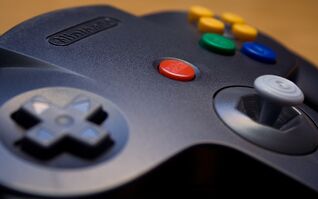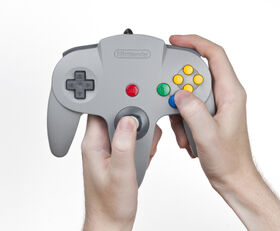The Nintendo 64 controller (NUS-005) is the standard game controller included with the Nintendo 64.
Overview[]
Design[]

A Black Official Nintendo Controller
The controller for the Nintendo 64 was designed to be held in several different positions. It was designed around Super Mario 64. It could be held by the two outer grips, allowing use of the digital D-pad, right-hand face buttons and the "L" and "R" shoulder buttons (but not the "Z" or analog stick). It could be also held by the center and right-hand grip, allowing the use of the single control stick, the right hand-buttons, the "R" shoulder button, and the "Z" trigger on the rear (but not the "L" shoulder button or D-pad). Finally, one controller could be held in each hand with a thumb on each analog stick and index fingers on the "Z" trigger. This setup allowed dual-analog control on some first-person shooters such as Perfect Dark. More often than not the analog stick was used in games while in some, both the control stick and directional pad could be interchangeable (ex: Mortal Kombat Trilogy). Very few games used the directional pad exclusively; two examples are the 3D puzzle game Tetrisphere and the side-scrolling platformer Kirby 64: The Crystal Shards.
The controller also included four "C buttons", which were originally intended to control the camera in the N64's three dimensional environments. However, since the pad only contained three other face buttons, the C-buttons often became assigned to ulterior functions. An example of this is The Legend of Zelda: Ocarina of Time, where three of the C-buttons can be assigned to secondary items and the upper C-button is used to orient the camera.
One game, Robotron 64, allowed one player to use two controllers to control an avatar. This way the game played like its predecessor, Robotron 2084. Star Wars Episode 1: Racer, GoldenEye 007 and Perfect Dark also used this set up for slightly different gameplay experiences (in terms of control, at least) compared to the standard single controller option.
The controller initially came in six colors (grey, black, red, green, yellow and blue; a dark blue controller was additionally shown with the other six at Shoshinkai 95 but never released) but other colors were released later, many of them coinciding with the release of a similarly color or designed system. Some of these others include smoke black, watermelon red, jungle green, fire orange, ice blue, grape purple, and special edition colors like gold, atomic purple, extreme green, "Donkey Kong 64" banana bunch yellow, "Pokémon" blue/yellow and "Millennium 2000" platinum.
Analog stick[]

For many years, console designers and manufacturers ignored analog stick technology, instead preferring the digital D-pad. It was not until the emergence of 3D gameplay that the analog thumb stick was put into widespread use.[citation needed] Using a D-pad in a 3D game greatly limits the player's ability to accurately utilize 360° of motion.
However, with the prevalence of analog sticks, the aforementioned D-pad limitation was no longer an issue. The Nintendo 64 wasn't the first console to use a joystick (Atari systems were first), and Sega's analog Mission Stick for Sega Saturn (which launched on September 29, 1995) as well as Sony's Analog Joystick were released before the Nintendo 64 controller. However, the Nintendo 64 controller popularized the idea. Its release was followed during the fifth generation by Sony's Dual Analog and DualShock controllers for the PlayStation system as well as Sega's 3D control pad for their Saturn system.
The analog stick was prone to some long-term reliability issues. The thumb could easily work its way off the stick. Part of the stick could be scraped away, which can be proven by a powder-like substance near the stick. After a while, the stick became "loose", which means it will not fully return to center position, which may render gameplay more difficult by giving unintended, non-user input to the system. This loosening can be caused by rotating it intensively - a common practice in games like Mario Party. Excessive rotating of the analog stick even resulted in blisters and burns to the hands, and Nintendo offered protective gloves to prevent injuries.
LodgeNet Variant[]

In 1997 Lodgenet Interactive and Nintendo released a controller and game playing service for various hotels in the United States. A slightly modified N64 controller that could hook into hotel televisions (and not an actual N64) was able to act as a remote control and game controller. Customers could pick from a large library of N64 games (including most first-party N64 titles) and play at a rate of $6.95 for every 60 minutes. The controller and video game rental service is still available and in use at some locations.
Electronic[]
The controller is the primary user interface for the N64. With its trident shape, it is probably the most unusual design for a controller on the market today. The standard N64 controller has 14 buttons plus an analog joystick. The buttons include:
- Four buttons arranged as a directional pad on the top left
- Start button in the top middle
- Six action buttons on the top right
- One action button on the front left
- One action button on the front right
- One action button in the bottom middle
- Analog joystick on the top middle

Although each button can be configured to perform a specific and distinctive action, they all work on the same principle. In essence, each button is a switch that completes a circuit when it is pressed. A small metal disk beneath the button is pushed into contact with two strips of conductive material on the circuit board inside the controller. While the metal disk is in contact, it conducts electricity between the two strips. The controller senses that the circuit is closed and sends that data to the N64. The CPU compares that data with the instructions in the game software for that button, and triggers the appropriate response. There is also a metal disk under each arm of the directional pad. If you're playing a game in which pushing down on the directional pad causes the character to crouch, a similar string of connections is made from the time you push down on the pad to when the character crouches.
The analog joystick works in a completely different way from the buttons described above. Two wheels are positioned at right angles to each other below the joystick. Whenever the joystick is moved, the two wheels turn slightly. Tiny slots are arranged around the perimeter of each wheel. The wheels are each mounted between an LED (Light Emitting Diode) and a photo cell. Light from the LED, shining through the slots in the wheel on the cell, creates a small amount of current. When the amount of light changes, the level of current changes. By monitoring the output of each photo cell, the N64 can determine the exact angle at which the joystick is being held, and trigger the appropriate response.
Another feature of the N64 controller is the ability to add options via an expansion slot on the bottom of the controller. A popular option is the Rumble Pak, which provides force feedback. This feature provides a tactile stimulation to certain actions in a game. For example, in a racing game, you might feel a jarring vibration as your car slams into the wall.
Force feedback is actually accomplished through the use of a very common device, a simple electric motor. The shaft of the motor holds an unbalanced weight. When power is supplied to the motor, it spins the weight. Because the weight is unbalanced, the motor tries to wobble. But since the motor is securely mounted inside the Rumble Pak, the wobble translates into a shuddering vibration of the controller itself.
You can save games and high scores by using one of the special Flash memory cards. The card is inserted into the slot on the bottom of the N64 controller.
The N64 controller uses only three wires to connect to the console. There's a ground wire, another wire that supplies +3, 6 volts of power, and a third wire that carries all data. The controller sends the information for each button in sequence, and then receives data back from the console.